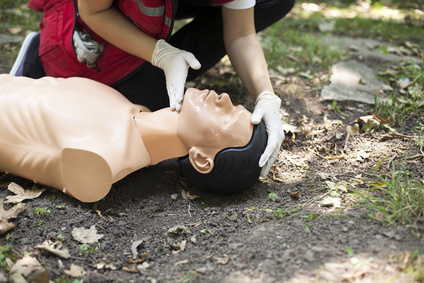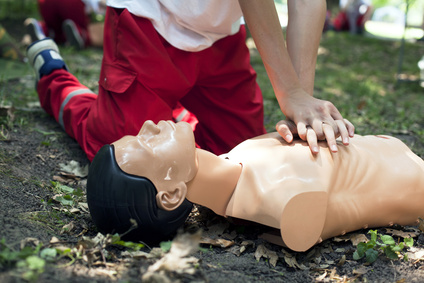When to Activate Emergency Response System
If possible, send someone to activate the Emergency Response System (call 911) and begin high-quality CPR immediately. Use an AED if there is one available at the scene. If you’re not with someone and you do not have a mobile phone, leave the patient to activate the Emergency Response System while also retrieving an AED.
Here's how to perform high-quality CPR (compressions plus ventilation):
Adult and Adolescent CPR
When a cardiac arrest is presumed begin CPR. The risk of harm is low if the patient is not in cardiac arrest. For patients in cardiac arrest with a non-shockable rhythm, it is reasonable to administer epinephrine as soon as feasible.
Scene Safety and Recognition of Cardiac Arrest: Check for safety (for rescuers and victims) and responsiveness, breathing, and gasping. Check the pulse for more than 5 seconds but within 10 seconds (breathing and pulse check can occur simultaneously).
Check Pulse: Test the pulse by placing two fingers on the carotid artery. Press your index and 3rd finger on the side of the neck, against the windpipe. You can also check the wrist by placing the same two fingers on the inside of the wrist below the thumb.
C is for Circulation – Adult and Adolescent Compressions
Circulation: Chest compressions circulate the blood within the patient. It's important to place your hands correctly upon the patient’s chest. Chest Compression Tempo: Perform CPR while matching the tempo of the song "Staying Alive" while making sure to push hard and fast.
Compression-ventilation ratio without Advanced Airway
Make sure the adult or adolescent is resting upon a firm, solid surface. Perform chest compressions on the lower half of the breastbone (sternum). Once in position, lock your elbows and use your body’s weight to compress at least 2 inches (5 cm) upon the patient’s chest. Do not lean on the patient’s chest in between compressions and make sure the chest ultimately recoils. Limit all interruptions to less than 10 seconds while performing CPR.
It’s important to note: When performing chest compressions on an adult or adolescent you should compress at least 2 inches (5 cm). The compression rate is 100-120/min. Two Rescuers: Perform tasks simultaneously. Administer compressions over breathing 30:2.
Chest Compression Fraction is the total percentage of resuscitation time when performed by the rescuer(s) during cardiac arrest. Try to minimize pauses in chest compressions. Chest Compression Fraction Goal: Target of at least 60 percent.
Compression-ventilation ratio with Advanced Airway
Perform continuous compressions at a rate of 100-120/min. Provide one breath every 6 seconds (10 breaths/min).
A is for Airway - Clear the airway
Airway: Make sure the patient is on a solid surface on their back. Kneel next to the patient’s neck and shoulders. Open the patient’s airway by tilting the head back with the palm of one hand while gently lifting the chin with your other hand. For no more than 10 seconds, check for life: listen for any sounds and put your cheek next to the patient’s mouth to feel any breaths while also looking for any motion. Rescuers can check steps simultaneously. If the patient is assumed lifeless, begin mouth-to-mouth.
B is for Breathing - Mouth-to-Mouth
Rescue Breathing: Is widely known to be performed mouth-to-mouth. It can also be performed mouth-to-nose, but this form is only used in rare cases. While still performing the airway technique, pinch the patient’s nose shut. With a complete seal over the patient’s mouth with your mouth, breathe until you see the chest inflate. If the chest does not rise, repeat the airway technique. Once the chest swells, breathe into the patient a second time (30:2).
Once the breathing technique is applied, continue Circulation, Airway, Breathing (C-A-B’s).
Rescuers Should Never
- Compress slower than 100/min or faster than 120/min
- Compress in-depth less than 2 inches (5 cm) or more than 2.4 (6 cm)
- Lean on victim’s chest during compressions
- Allow interruption during compressions for more than 10 seconds
- Provide excessive ventilation during breathing task (i.e., excessive breathing with force or too many breaths)
Opioid poisoning CPR for lay persons
1. For suspected opioid poisoning
- Check responsiveness
- Shout for nearby help
- Activate the emergency response system
- Get naloxone and an AED if possible
2. Is the patient breathing normally?
If yes, prevent deterioration:
- Tap and shout
- Reposition
- Consider naxolone
- Continue to assess responsiveness and breathing until EMS arrives
If no, start CPR:
- Give naxolone
- Use an AED
- Resume CPR until EMS arrives
CPR on a pregnant patient
Oxygenation and airway management should be prioritized during resuscitation from cardiac arrest in pregnancy because pregnant patients are more prone to hypoxia (a condition in which the body or a region of the body is deprived of adequate oxygen supply).
Fetal monitoring should not be undertaken during cardiac arrest in pregnancy because of potential interference with maternal resuscitation.
CPR on a pregnant person should be performed as you would on a non-pregnant patient.
- Check the environment and make sure it’s safe for rescuers and victims
- Remove any physical obstructions in the immediate area (i.e., belongings, debris, small pieces of furniture)
- Check responsiveness
- No breathing or only gasping (no normal breathing)
- No positive pulse within 10 seconds
- You can check for a pulse and breathing simultaneously in less than 10 seconds
- If you do not have a mobile phone, leave the victim and activate the emergency response system while retrieving an AED before performing CPR
- Have someone activate the emergency response system
- Perform CPR immediately
- Use the AED as it becomes available
- 1 or 2 rescuers – 30:2
- Chest compressions – 100-120/min
- Give one breath every 6 seconds (10 breaths/min)
- 100-120/min
- At least 2 inches (5 cm)
- Two hands on the breastbone (sternum) on the lower half
- Make sure not to lean on the chest of the victim.
- Allow full recoil after each chest compression.
- Compression interruptions should be limited to less than 10 seconds
- Compress slower than 100/min or faster than 120/min
- Compress in-depths less than 2 inches (5 cm) or more than 2.4 (6 cm)
- Lean on victim’s chest during compressions
- Allow interruption during compressions more than 10 seconds
- Provide excessive ventilation during breathing task (ie., excessive breathing with force or too many breaths)





